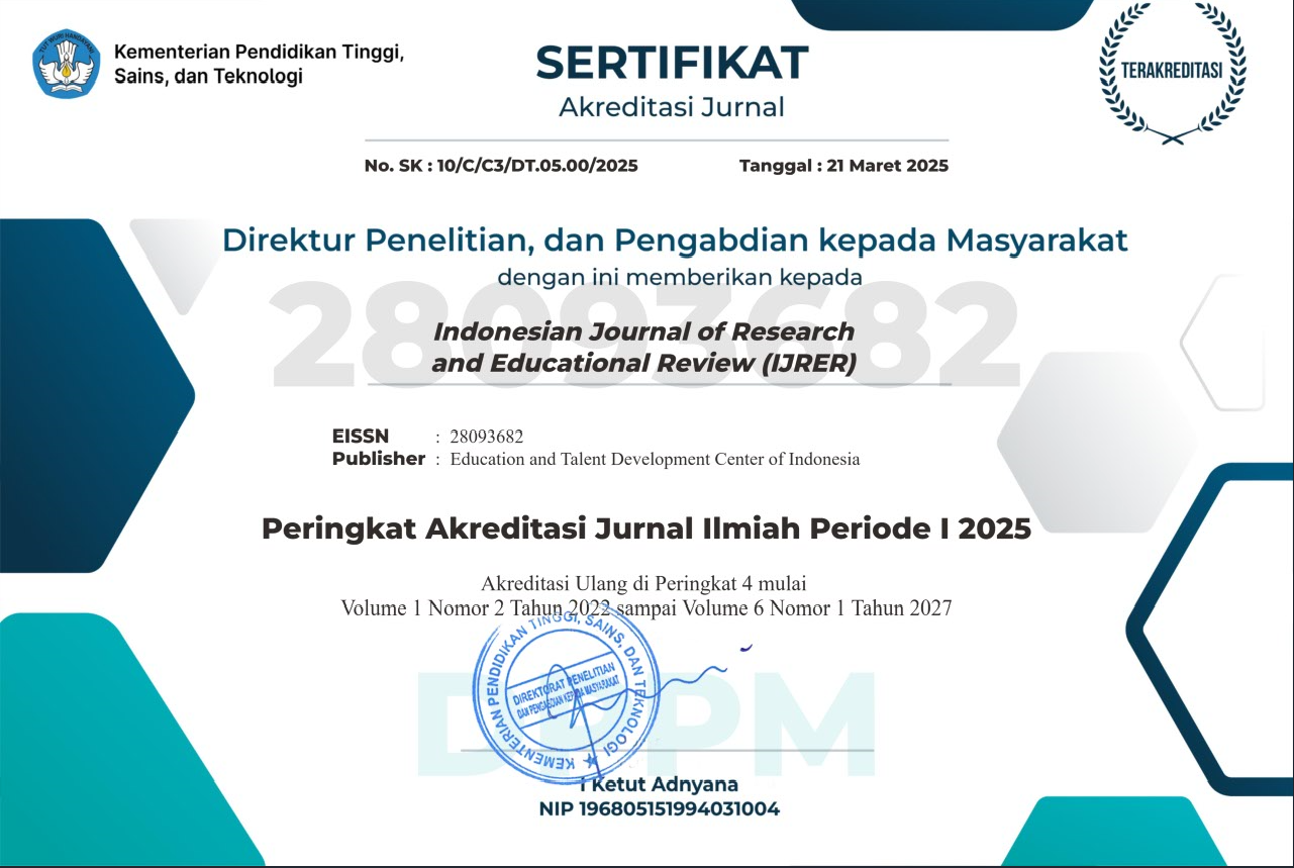Students’ Vocabulary Mastery By Using Animation Video on English Language Teaching
DOI:
https://doi.org/10.51574/ijrer.v1i3.391Keywords:
Vocabulary Mastery, Animation Video, ELTAbstract
The purpose of the study was to determine whether or not the second-year students at MTs As'adiyah Putri 1 Sengkang benefit from using animation videos to expand their vocabulary. The pre-experimental approach was used by the researcher, who used a one-group pre-test and post-test design. The second year of MTs As'adiyah Putri 1 Sengkang in the academic year 2020–2021 made up the study's population. The information was gathered via a vocabulary exam (pre-test and post-test). Cluster random sampling was employed as the sampling method. The researcher conducted a t-test study to determine whether or not the usage of video as a teaching tool improved students' vocabulary. The examination of the data revealed a substantial difference between the pre-test and post-tests. It was demonstrated by the significance value of 0.000, which was lower than the level of significance (α) = 0.05. The average post-test score (84.50) exceeded the average pre-test score (52.90). Based on the study's data and analysis, the author came to the conclusion that employing video as a teaching tool improved the vocabulary of second-year MTs As'adiyah Putri 1 Sengkang.
References
Almazova, N., & Kogan, M. (2014). Computer assisted individual approach to acquiring foreign vocabulary of students major. In International Conference on Learning and Collaboration Technologies (pp. 248-257). Springer, Cham. https://doi.org/10.1007/978-3-319-07485-6_25
Amalia, R. (2017). Improving listening and speaking skills by using animation videos and discussion method. Pedagogy: Journal of English Language Teaching, 2(1), 30-36. https://e-journal.metrouniv.ac.id/index.php/pedagogy/article/view/652
Amiruddin, & Razaq, Y. (2022). The Use of Flashcards to Improve Students’ Vocabulary Achievement. ETDC: Indonesian Journal of Research and Educational Review, 1(2), 145-151. https://doi.org/10.51574/ijrer.v1i2.332
Ansarin, A. A., & Khabbazi, S. K. (2021). Task-induced involvement load and working memory: Effects on active and passive vocabulary knowledge of EFL learners in a multimedia learning environment. Eurasian Journal of Applied Linguistics, 7(1), 277-302.
Barwasser, A., Knaak, T., & Grünke, M. (2020). The Effects of a Multicomponent Storytelling Intervention on the Vocabulary Recognition of Struggling English as a Foreign Language Learners With Learning Disabilities. Insights into Learning Disabilities, 17(1), 35-53.
Bronack, S. C. (2011). The role of immersive media in online education. The Journal of Continuing Higher Education, 59(2), 113-117.
Buckingham, D. (2007). Digital Media Literacies: rethinking media education in the age of the Internet. Research in comparative and international education, 2(1), 43-55.
Byun, J., & Loh, C. S. (2015). Audial engagement: Effects of game sound on learner engagement in digital game-based learning environments. Computers in Human Behavior, 46, 129-138. https://doi.org/10.1016/j.chb.2014.12.052
Cakir, I. (2006). The use of video as an audio-visual material in foreign language teaching classroom. Turkish Online Journal of Educational Technology-TOJET, 5(4), 67-72. https://eric.ed.gov/?id=EJ1102619
Cash, P., Stanković, T., & Štorga, M. (2016). An introduction to experimental design research. In Experimental design research (pp. 3-12). Springer, Cham. https://doi.org/10.1007/978-3-319-33781-4_1
Collins, K. (2013). Playing with sound: a theory of interacting with sound and music in video games. MIT press.
Daskalovska, N. (2020). Vocabulary size at four stages of language development. European Journal of English Language Teaching, 6(2).
Fan, M. (2000). How big is the gap and how to narrow it? An investigation into the active and passive vocabulary knowledge of L2 learners. Relc journal, 31(2), 105-119. https://doi.org/10.1177/003368820003100205
Gross, T., Taylor, A. G., & Joudrey, D. N. (2015). Still a lot to lose: the role of controlled vocabulary in keyword searching. Cataloging & classification quarterly, 53(1), 1-39. https://doi.org/10.1080/01639374.2014.917447
Hamer, W., & Lely, L. N. (2019). Using Pictionary Game to Increase Learners’ Vocabulary Mastery in English Language Instruction. Journal of English Education Studies, 2(1), 43-51.
Hasbi, M., Munawir, A., Ahmad, G., & Khair, U. (2022). Teaching Vocabulary Using Games: Empowering Students' Interest in ELT Classrooms. PATIKALA: Jurnal Pengabdian Kepada Masyarakat, 1(3), 155-160.
Höffler, T. N., & Leutner, D. (2007). Instructional animation versus static pictures: A meta-analysis. Learning and instruction, 17(6), 722-738.
Jackson, H. (2014). Words and their Meaning. Routledge.
Kamil, M. L., & Hiebert, E. H. (2005). Teaching and learning vocabulary. Teaching and learning vocabulary: Bringing research to practice, 1, 76-77.
Keles, A. (2015). The Role of Films in Literature Education at Departments of German Language and Literature in Turkey. Procedia-Social and Behavioral Sciences, 197, 652-658.
Laaser, W., & Toloza, E. A. (2017). The changing role of the educational video in higher distance education. The International Review of Research in Open and Distributed Learning, 18(2). https://doi.org/10.19173/irrodl.v18i2.3067
Lervåg, A., & Aukrust, V. G. (2010). Vocabulary knowledge is a critical determinant of the difference in reading comprehension growth between first and second language learners. Journal of Child Psychology and Psychiatry, 51(5), 612-620. https://doi.org/10.1111/j.1469-7610.2009.02185.x
Mayer, R. E., & Moreno, R. (2002). Animation as an aid to multimedia learning. Educational psychology review, 14(1), 87-99. https://doi.org/10.1023/A:1013184611077
Milton, J. (2022). Vocabulary denial and the false god of structuralism in Ofsted’s 2021 Curriculum Research Review for languages. The Language Learning Journal, 50(2), 156-171. https://doi.org/10.1080/09571736.2022.2045680
Munawir, A., Inayah, N., Marya, A., & Huda, N. (2022). Outdoor Learning: Students’ Vocabulary Mastery in Higher Education. ETDC: Indonesian Journal of Research and Educational Review, 1(2), 210-216. https://doi.org/10.51574/ijrer.v1i2.338
Munir, F. (2016). The effectiveness of teaching vocabulary by using cartoon film toward vocabulary mastery of EFL students. Journal of English Language Teaching and Linguistics, 1(1), 13-37. http://dx.doi.org/10.21462/jeltl.v1i1.20
Murthy, N. S. R. (2020). Techniques for Teaching/Learning Vocabulary: A Brief Study. Journal for Research Scholars and Professionals of English Language Teaching, (19). https://papers.ssrn.com/sol3/papers.cfm?abstract_id=3630162
Onwuegbuzie, A. J., & Abrams, S. S. (2021). Nonverbal communication analysis as mixed analysis. In The Routledge Reviewer's Guide to Mixed Methods Analysis (pp. 239-258). Routledge.
Radu, I. (2014). Augmented reality in education: a meta-review and cross-media analysis. Personal and ubiquitous computing, 18(6), 1533-1543.
Riccomini, P. J., Smith, G. W., Hughes, E. M., & Fries, K. M. (2015). The language of mathematics: The importance of teaching and learning mathematical vocabulary. Reading & Writing Quarterly, 31(3), 235-252. https://doi.org/10.1080/10573569.2015.1030995
Roggema, R. (2016). Research by design: Proposition for a methodological approach. Urban science, 1(1), 2. https://doi.org/10.3390/urbansci1010002
Rukmini, D., & Sutopo, D. (2013). The use of picture games to improve students’ motivation in learning vocabulary. English Education Journal, 3(2).
Shreedhar, G., & Mourato, S. (2019). Experimental evidence on the impact of biodiversity conservation videos on charitable donations. Ecological Economics, 158, 180-193. https://doi.org/10.1016/j.ecolecon.2019.01.001
Silfia, L., Rusli, T. I., & Nasrullah, R. (2018). Teaching vocabulary to young learners by using animation video. MetaCommunication; Journal Of Communication Studies, 3(1). http://dx.doi.org/10.20527/mc.v3i1.4783
Siregar, A. S. B., Tobing, E. G. L., & Fitri, N. R. (2021). Developing of Teaching Materials: Using Animation Media to Learning English Vocabulary for Early Childhood. ETDC: Indonesian Journal of Research and Educational Review, 1(1), 9-16. https://doi.org/10.51574/ijrer.v1i1.44
Sudarmaji, I., & Yusuf, D. (2021). The Effect of Minecraft Video Game on Students’ English Vocabulary Mastery. JETAL: Journal of English Teaching & Applied Linguistic, 3(1), 30-38.
Tanner, L. R., Haddock, S. A., Zimmerman, T. S., & Lund, L. K. (2003). Images of couples and families in Disney feature-length animated films. The American Journal of Family Therapy, 31(5), 355-373.
Traore, M., & Kyei-Blankson, L. (2010). Using literature and multiple technologies in ESL instruction. Journal of Educational Multimedia and Hypermedia, 19(4), 451-467. https://www.learntechlib.org/p/35485/
Traore, M., & Kyei-Blankson, L. (2011). Using literature and multiple technologies in ESL instruction.
Wang, M., Hong, R., Yuan, X. T., Yan, S., & Chua, T. S. (2012). Movie2comics: Towards a lively video content presentation. IEEE Transactions on Multimedia, 14(3), 858-870.
Webb, S. (2008). Receptive and productive vocabulary sizes of L2 learners. Studies in Second language acquisition, 30(1), 79-95.
White, T. (2013). How to Make Animated Films: Tony White's Complete Masterclass on the Traditional Principles of Animation. Routledge.
Wijaya, I., Bakri, R., Wutun, A., Fitriani, F., & Mattoliang, A. (2019). The effectiveness of mobile learning based android in learning English vocabularies.
Zhong, H. F. (2018). The relationship between receptive and productive vocabulary knowledge: A perspective from vocabulary use in sentence writing. The Language Learning Journal, 46(4), 357-370. https://doi.org/10.1080/09571736.2015.1127403














1.png)













